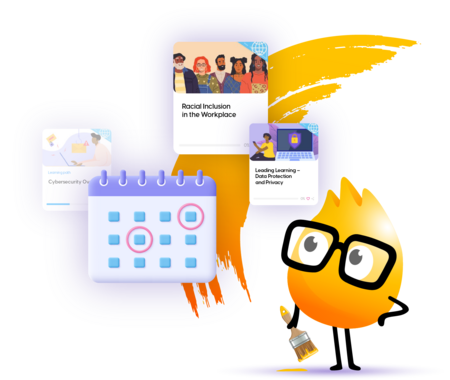Six Steps to Launch a Successful L&D Program
You probably know a lot about why you should train your workforce. But how do you actually plan a successful learning program?
When we talk about learning and development (L&D), we tend to talk about the “why” of learning: workplace learning boosts engagement, aids in retention, and helps you upskill your workforce. We don’t however, always address the “how”: How exactly do you start planning your L&D initiative? Who do you include? What content gets built first?
This can be especially daunting for a small organization without a dedicated L&D team. You know you need to train your workforce, but how do you start? This article is intended to be a starting point by providing six steps for helping you launch a strong learning program.
Steps to launching an L&D program
Learning isn’t one-size-fits all. Your learners’ needs are unique, and so is your organization. When you create your program, it should aim to meet your organization’s unique learning and business needs. The following steps will help you build a program tailored to your learners and your organization.
1. Don’t underestimate the importance of planning
You might be impatient to get your learning initiative off the ground, but strong L&D programs need a thorough planning process. Be intentional with your planning rather than simply reacting to a learning need.
When planning your L&D program, here are some questions to ask yourself:
- How will a new training initiative impact other departments within the organization?
- How will a new L&D program impact any other training initiatives your team may be involved in?
- When is the best time to roll out a new L&D strategy in your company or industry?
- What are the realities that might constrain the development of an L&D initiative?
By understanding the parameters of your organization — your budget, your time limits, and the number of learners you’re training — it’s possible to design a program that can work for your team without getting overwhelmed by your options.
It’s also important to know which people should be included in the planning process from the beginning. L&D shouldn’t be operating in a vacuum. Leadership should be involved early on. Senior leadership understands organizational needs and limits, and may be able to envision how the L&D program should evolve to meet training needs in the future.
2. Understand your organization’s needs and goals
Before you can build a training program, you have to know what challenges are being solved by that program. What do you want to achieve with this training program? Are there certain skills that need to be built in your team, or is training tied to organizational objectives, such as upskilling or DEI initiatives?
Whatever your goals, they need to be clearly defined, and that means analyzing data that can help you identify the business needs of the organization. Knowing what you want your training to achieve will help you measure your results later.
3. Define learning objectives
Your organization should have learning objectives, and those should be aligned with the business needs you’ve already defined. You should also know how you are going to measure these learning objectives before launching your L&D program.
Learners should also have their own learning objectives. Work with managers to identify the learning needs of their teams — their strengths and areas of improvement — and create objectives that address each. You may want to ask learners’ input on their own learning objectives; some of your team members may be interested in specific skills and will find training more relevant or useful if their individual goals are being met.
4. Start small
It’s easy to get excited and make big plans for your new L&D program, however, it’s best to start slowly. Choose your most important learning objectives first, and build modules that tackle those, taking the time to get them right before rolling them out to your learners and managers.
Introducing your new learning program to managers is important because they’ll be the ones reinforcing the learning you deliver to their teams. You want everyone to be comfortable with your content. You also want to be able to measure the impact of these initial modules, so starting with just a few high-priority ones can make measurement more manageable.
Once you’ve gotten the initial learning designed, you can expand to content that addresses other learning objectives or add the bells and whistles you’re excited about.
5. Manage change
Not everyone gets excited about new learning, and some people may even resist it. Decide ahead of time what your implementation plan is. This includes developing communication plans to inform employees of upcoming L&D changes, and it means that leadership will have to get on board.
Employees hear the messages their bosses give them about learning. If leadership is able to communicate the importance of a new learning initiative, chances are you’ll have much better engagement from your learners.
6. Review your content continuously
Your L&D is a living project. You can’t create it once and leave it. You should constantly be working to refine your content and delivery, and you should always be assessing organizational needs to see what new content needs to be built. Make sure you’re collecting data, not just in the form of pre-determined KPIs, but also in the form of feedback from learners and managers. What worked well for them? What didn’t work? This feedback will help your L&D program grow and improve.
The importance of a strong L&D program
Your learners are constantly working to achieve the goals of your organization. It’s important that you make it a priority to invest in them as well, making sure they have the tools and the knowledge to do their jobs well.
By building a well-thought-out L&D program, you can ensure that their needs are met, while also achieving the business goals of your organization. Ready to launch your L&D program with confidence? Get your free copy of “L&D Made Easy: Your Guide to Impactful Lean L&D” today!




